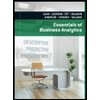A firm faces uncertain revenues and uncertain costs. Its revenues may be $120,000, $160,000, or $175,000, with probabilities .2, .3, and .5, respectively. Its costs are $150,000 or $170,000 with chances .6 and .4, respectively. (Revenues and costs are independent.) a. How many possible profit outcomes exist? Draw a decision tree listing these profit outcomes at the branch tips. Compute the firm’s expected profit by folding back the tree. (It does not matter which uncertainty, demand or cost, is resolved first in the tree.) b. Without a decision tree, calculate separately the firm’s expected revenue and expected cost. What is the firm’s expected profit? (This result underscores a great computational convenience of the expected-value criterion. Expected profit is equal to expected revenue minus expected cost; that is, expectations can be taken separately.)
A firm faces uncertain revenues and uncertain costs. Its revenues may be
$120,000, $160,000, or $175,000, with probabilities .2, .3, and .5,
respectively. Its costs are $150,000 or $170,000 with chances .6 and .4,
respectively. (Revenues and costs are independent.)
a. How many possible profit outcomes exist? Draw a decision tree listing
these profit outcomes at the branch tips. Compute the firm’s
expected profit by folding back the tree. (It does not matter which
uncertainty, demand or cost, is resolved first in the tree.)
b. Without a decision tree, calculate separately the firm’s expected
revenue and expected cost. What is the firm’s expected profit? (This
result underscores a great computational convenience of the
expected-value criterion. Expected profit is equal to expected revenue
minus expected cost; that is, expectations can be taken separately.)
Trending now
This is a popular solution!
Step by step
Solved in 2 steps with 1 images






